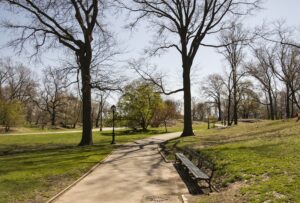
The positive impact of nature on human health is often attributed to nature’s inherent stress reducing effects. As (chronic) stress has a well-known detrimental effect on health, it can directly or indirectly contribute to the epidemic of non-communicable diseases (NCDs), such as diabetes, cardiovascular disorders, and mental disorders.
How do we behave when feeling stressed?
When we feel exhausted, we seek a means to decrease the ‘bad’ feeling. One way of doing this is by searching for a place that provides:
- shelter
- a safe and secure haven
- view and surveillance (of the surroundings)
- water and a lush environment
- no sharp noise
- no demands

Having the possibility to restore our capacities in natural areas, or at least in areas that can provide the same stimuli, is extremely important.
Unfortunately, today’s living environments provide less access to urban parks. With increasing stress and less physical activity in everyday situations, the result can be a negative impact on our mental health, leading to stress-related mental diseases. One of these is mental fatigue, a state consisting of difficulties with directing attention. As a result, it is hard to sort information, prioritise, make decisions, and carry through what is decided.
What qualities do we seek from a natural area?
Research shows that urban parks and natural areas give us several qualities that are perceived as recreational, and thus can contribute to our well-being. These areas speak to many (if not all) of our senses, and provide:
- Serenity: Peace, silence, and signs of care, safety and security; sounds of wind, water, birds, and insects. No rubbish, no weeds, no other people, or just a few.
- Nature: Plants seem self-sown. Lichen- and moss-grown rocks, old paths; created not by humans, but by the power of something mightier.
- Richness in species: An outdoor area offering a variety of species of animals and plants.
- Space: An outdoor area offering a restful feeling of “entering another world”.
- Prospect: A green, open place with room for vistas, and a place that invites you to stay.
- Refuge: A sanctuary, an enclosed, safe, secret and secluded place where you can relax, be yourself, experiment and play.
- A social arena: A meeting place for festivity and pleasure.
- Culture: A place offering fascination through evidence of people’s values, beliefs, efforts and toils, and perhaps with the passage of time.
The more qualities (out of serenity, nature, a richness in species, space and culture) we have close to us, the more satisfied we feel about our neighbourhood, the more physical activity we do, and the lower a BMI we tend to have.

Which is the most important quality?
It seems that serenity is the quality most associated with different aspects of wellbeing. A serene environment facilitates rehabilitation and makes you cope with stress in a better way. Serenity in everyday life could contribute to a more positive development in public health.
The importance of sound
Sounds are an important aspect of creating health-promoting environments. To be able to hear the sounds of serenity – calming sounds from nature – there mustn’t be any traffic noise or even noise from other people.
Natural sounds are important to include when trying to create rehabilitating indoor environments since stress recovery seems to be facilitated in a setting with both visual and auditory nature stimuli. Without sound, the situation tends to feel surrealistic and too quiet.
This topic was presented by Patrik Grahn at the Care for Sound symposium.
Watch the full presentation below:

